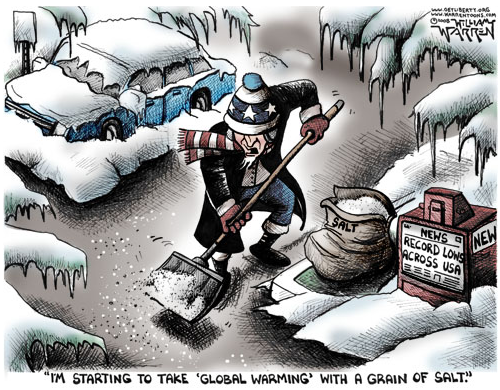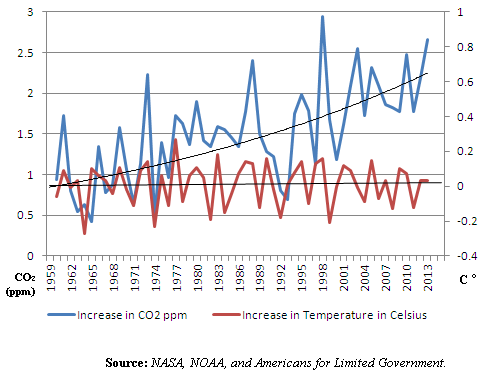No warming.
That is what can be deduced from data compiled by NASA as it relates to temperature over the past decade.
The average temperature in 2003 was 14.61 degrees Celsius. And the average temperature in 2013 was 14.61 degrees Celsius, at a growth rate of 0 percent.
Yet, carbon dioxide in the atmosphere increased by more than 5.5 percent, from 375.77 parts per million (ppm) to 396.48 ppm, according to National Oceanic and Atmospheric Administration (NOAA).
Curious.
In fact, since 1959 — as far back as NOAA’s dataset goes for carbon dioxide levels — carbon dioxide has increased a whopping 25.48 percent, from 315.97 ppm to today’s level of 396.48 ppm.
Yet, temperatures are up a mere 4.2 percent, from 14.02 degrees Celsius to its current level of 14.61 degrees. UPDATE 3/14, 11AM: This is less important, since temperature in Celsius is an interval type of data, whereas carbon emissions are a quantitative, ratio type of data with a zero reading being possible at least in principle. This makes comparing the overall growth rates between the two extremely problematic, because depending on the temperature scale used — Celsius, Fahrenheit, and Kelvin — the growth rate will vary wildly. However, we can still compare acceleration. Read on.
Casting further doubt on the UN Intergovernmental Panel on Climate Change’s man-made global warming hypothesis, carbon emissions have been accelerating, too. For example in the 1960s, they grew at an average rate of 0.27 percent a year, 0.39 percent in the 1970s, 0.45 percent in the 1980s, 0.42 percent in 1990s, and 0.54 percent in the 2000s.
Shouldn’t temperatures be accelerating, too?
They only grew at an average rate of 0.18 percent in the 2000s. That compares with 0.01 percent average annual increase in the 1990s, 0.12 percent in the 1980s, and 0.14 percent in the 1970s. In the 1960s, temperatures actually dropped an average annual 0.39 percent rate, even as emissions increased.
Does this suggest that the more carbon increases, the less impact it has on temperature?
In fact, that is more or less what the Intergovernmental Panel on Climate Change predicts, from their 2011 report: “Equilibrium GCM 2 x CO2 experiments commonly assume a radiative forcing equivalent to a doubling of CO2 concentration (for example from 300 ppmv to 600 ppmv). In fact the absolute concentrations are not especially important, as the temperature response to increasing CO2 concentration is logarithmic – a doubling from 500 to 1000 ppmv would have approximately the same climatic effect.” This of course makes the impact of CO2 in the atmosphere an extremely important topic.
As Christopher Monckton in his 2008 paper, “Climate Sensitivity Reconsidered,” “Estimating ‘climate sensitivity’ – the magnitude of the change in temperature after doubling CO2 concentration from the pre-industrial 278 parts per million to ~550 ppm – is the central question in the scientific debate about the climate.”
A better question then might be to what degree the rate of increase in carbon emissions actually affects temperatures? The below chart shows CO2 increasing at a rate far faster than temperatures.
In the meantime, policy makers at the Environmental Protection Agency (EPA) say we have to take their word for it and attempt to curb carbon emissions here in the U.S. — if that’s even possible — while those emissions promise to continue growing unabated overseas at an ever-faster pace.
According to BP, carbon emissions will increase by 29 percent by 2035 based on continued growth in emerging markets.
That implies carbon dioxide will be at a whopping 114.98 ppm above today’s levels, or an average annual increase of 1.3 percent. That is faster than carbon dioxide has ever grown.
And so, if carbon emissions will be accelerating over the next couple of decades, then temperatures should, too, eventually. Right?
The good news is we’ll find out very soon if the rapidly increasing carbon emissions result in the increasing temperatures the UN has predicted. So far, they have not, calling into question why the EPA is issuing any carbon emission restrictions. This isn’t settled at all.
Robert Romano is the senior editor of Americans for Limited Government.
UPDATED: 3/14/14 11AM, 3/15/14 12:00PM RE: Reflecting that temperature in Celsius is an interval variable with no zero value versus CO2 being a ratio variable, which can have a zero reading, and to quote IPCC and Monckton.








